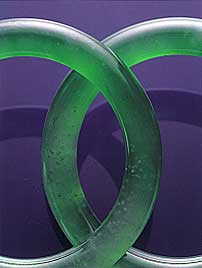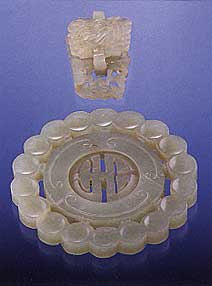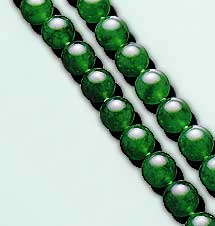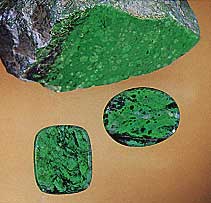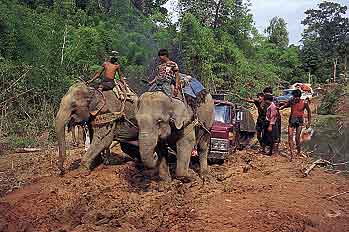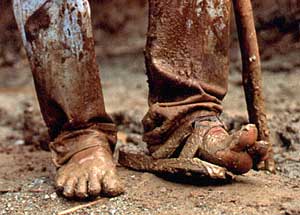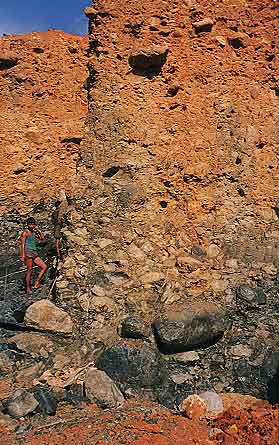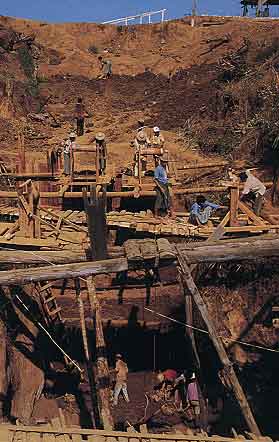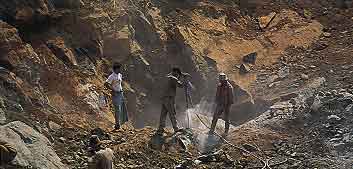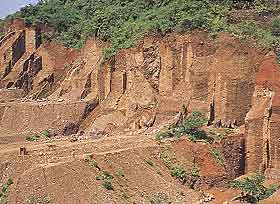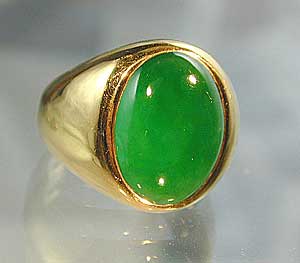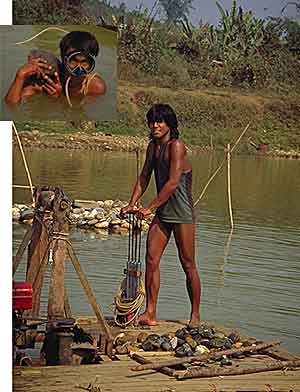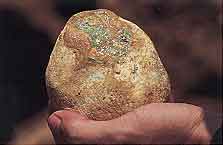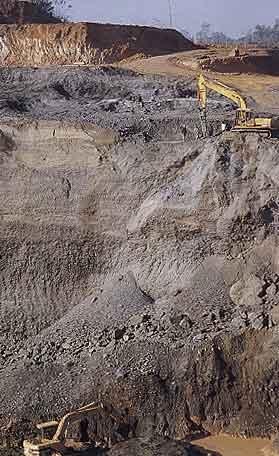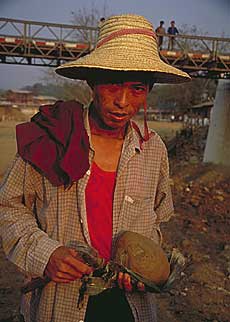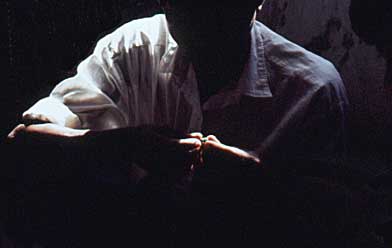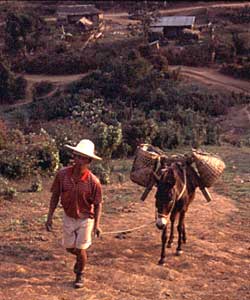Burmese Jade, Part 1
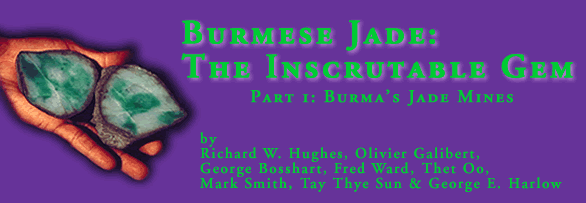
About the Authors
Mr. Hughes is an author, gemologist, and ex-webmaster of Pala International, Fallbrook, California. Mr. Galibert (FGA, hons.; ING, AG) is a gemologist and Hong Kong-based dealer in colored stones and pearls. Mr. Bosshart is chief gemologist, Research and Development, at the Gübelin Gem Lab, Lucerne, Switzerland. Mr. Ward, a gemologist, writer, and photographer, owns Gem Book Publishing, Bethesda, Maryland. Dr. Thet Oo is a gemologist and Yangon-based dealer in colored stones. Mr. Smith is a gemologist and Bangkok-based dealer in colored stones. Dr. Tay is president of Elvin Gems and Far Eastern Gemmological Lab of Singapore. Dr. Harlow is curator of Gems and Minerals at the American Museum of Natural History, New York City.
Acknowledgments and references appear at the end of Part 2 of this article. Also included is a Palagems.com Jadeite Buying Guide.
© 2000 Richard W. Hughes
Note: Portions of this article originally appeared in Gems & Gemology, Vol. 36, No. 1, pp. 2–26.
Abstract: The jadeite mines of Upper Burma (now Myanmar) occupy a privileged place in the world of gems, as they are the principal source of top-grade material. Part 1 of this article, by the first foreign gemologists allowed into these important mines in over 30 years, discusses the history, location, and geology of the Burmese jadeite deposits, and especially current mining activities in the Hpakan region.
Part 2 will detail the cutting, grading and trading of jadeite – in both Burma and China – as well as treatments. The intent is to remove some of the mystery surrounding the Orient’s most valued gem.
If jade is discarded and pearls destroyed, petty thieves will disappear, there being no valuables left to steal.
– From a dictionary published during the
reign of Emperor K’ang Hsi (1662–1722 AD), as quoted by Gump, 1962
THE TRACK LEADS down to a small encampment. As the sun’s first glow appears, its aura illuminates a Yunnan trader preparing for the day ahead. With a watchmaker’s care, all the possessions in his earthly world are gathered together and placed into burlap sacks. These are then strapped onto a mule’s saddle, a stone from the nearby river helping to balance the load.
He sets off in the misty light just before dawn, slowly working his way alongside a small river snaking through the valley bottom. The surrounding jungle pushes in everywhere, clothing all in a sticky green glow. Soon, the only noise is that of the man whistling softly, urging the animal on. Clip, clop, hoof against stone, one foot in front of the other, each step a mark of patience – down the track, into the sunlight… into history… into immortality… for the rock on the mule’s back is no ordinary stone. Burma’s jade mines are on the brink of discovery.
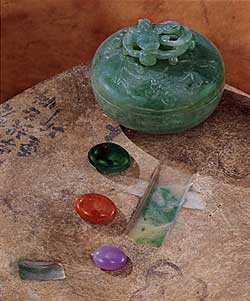 |
| Figure 1. “Windows” cut into this otherwise undistinguished boulder from the Burma Jade Tract reveal the presence of a rich green in the jadeite beneath the skin. Boulders such as this are the source of the fine green, orange-red, and lavender cabochons that are much sought-after in China and elsewhere. The bowl is approximately 6 cm wide x 5 cm high. The cabochons measure approximately 15 x 19 mm (green), 13 x 18 mm (orange-red), and 10 x 14 mm (lavender). Courtesy of Bill Larson and Pala International; photo © Harold & Erica Van Pelt. |
Some 700 years later, in the same remote corner of the planet, the scene has changed dramatically. The green cloak of jungle has been stripped away, replaced by naked earth. Across it crawl thousands of human ants, prying boulders loose from the compact brown soil. Yesteryear’s idyll is today broken by the sound of jack hammers, their a rat-a-tat beat punctuated by the cymbal crash of pick and shovel. In the background a choir of coolies stands at attention, baskets perched, ready to carry debris out of this earthen tomb. As a boulder is turned over, it is quickly examined, then discarded, along with the mounds of dirt that surround it. So the process is repeated. Over and over, again and again, hour after hour, day after day. The operation is a study in patience. Patience, patience – those who hurry lose, those who hurry make mistakes, those who hurry miss the prize – those who hurry don’t go to heaven. The construction of Egypt’s Great Pyramids was a similar study in patience, but with one important difference. That in Upper Burma consists of deconstruction, the dismantling of entire mountains, step by step, bit by bit, stone by stone, one pebble at a time. All involved share a single-minded devotion to the task. Patience, patience – those who hurry lose, they miss something, they don’t go to heaven. Those who hurry don’t find jade.
Welcome to Jade Land
Few localities in the world of gems are as singular as the jadeite mines of Hpakan, Upper Burma (now Myanmar*). These storied deposits and the green stone that emanates from them have long been shrouded in mystery. For starters, there is sheer geography. Burma’s Kyaukseinmyo (literally “Jade Land”) is located about 420 aerial km north of Mandalay, amidst some of the most inaccessible jungle on the planet. Due to monsoon rains, they are essentially cut off from the rest of the world for several months out of the year (see box, page 7). Now factor in a low-boil insurgency that has entangled the region for decades. But most important, this area is the primary source of a precious stone which sends nearly a quarter of the globe’s population into spasms of ecstasy. More Merlin than mineral, jade is a gem which some have referred to as an “enigma” (Hobbs, 1982).
But of equal importance is that jade connoisseurship is almost strictly a Chinese phenomenon. People of the Orient have developed jade appreciation to a degree found nowhere else in the world, but this knowledge is largely locked away in non-Roman-alphabet texts that are inaccessible to most Westerners, adding further to jadeite’s inscrutable reputation. The mines of Burma are the primary working deposits for the most prized gem in the Far East (figure 1), a stone exceeded in price only by diamond.
This article will draw back the curtain on this enigmatic gem, revealing the manner in which Burmese jadeite is mined, traded, graded, cut, treated, and faked. Since the major gemological features of jade have already been extensively covered in the literature (Hobbs, 1982; Fritsch et al., 1992; Wang, 1994), emphasis here will be on these lesser-known aspects. An understanding of jadeite is not limited to the technical or exacting, but it also requires a feeling for the cultural, textural, and ephemeral qualities that make the study of jade unlike any other in the world of gemstones.
Jade has a rich history in the Orient, especially China (Box A). Historically, the term jade was applied to any of a number of ornamental materials that could be carved, but most importantly amphibole jade, or nephrite. The rich green material subsequently found in Burma proved to be composed primarily of a different mineral (a pyroxene) and was named jadeite (see Box B). In this article, jade encompasses both jadeite and nephrite in those instances where the general carving material is being referenced, but jadeite or jadeite jade will be used to refer to the rock that is predominantly jadeite, where appropriate.
Although jadeite deposits are found throughout the world (Guatemala, Japan, Russia, and California), Burma remains the primary source of top-grade material. The Hpakan jadeite region (figure 2) is one of the wildest, least-developed areas of the country. Until the authors’ first trip, in 1996, no foreign gemologists had visited the mines since Edward Gübelin in 1963 (Gübelin, 1964–65, 1965a and b). One European known to have traveled in the general area was Swedish journalist Bertil Lintner, who in 1985–86 made an epic journey through rebel-held areas of northern Burma, including the region surrounding Hpakan (see, e.g., Lintner, 1996). But he was unable to visit the mines themselves.
On February 24, 1994, a formal cease-fire was signed between the Burmese government and the main rebel group, the Kachin Independence Army (Lintner, 1996). In June 1996, RWH, OG, MS, and TO made a brief trip to Hpakan (Hughes and Galibert, et al., 1996–97). To give some idea of the sensitivity of this area, months were needed to obtain permission, with final approval coming from the second-highest-ranking general in the ruling SLORC (State Law and Order Restoration Committee) military junta. RWH again visited the mines in March 1997, this time accompanied by FW and a German film crew led by Bangkok-based journalist Georg Muller (Hughes and Ward, 1997). This trip included a visit to Tawmaw. In November 1997, GB and TO paid a further visit to the Hpakan area, including a trip to Kansi and Maw Sit. Most recently, in January and February 2000, GEH visited the Nansibon jadeite deposits in the historic Hkamti area, which are located approximately 60 km northwest of Hpakan.
More than 2,500 years ago, Gautama Buddha recognized that much of life involves pain and suffering. Consequently, few of us here on Earth have been provided with a glimpse of heaven. Instead, we mostly dwell in hell. But for the Chinese, there is a terrestrial bridge between heaven and hell – jade. Jadeite (figure A-1) is a relatively recent entry to the jade family. While some traditionalists feel that it lacks the rich history of nephrite, nevertheless the “emerald” green color of Imperial jadeite is the standard by which all jades – including nephrite – are judged by most Chinese enthusiasts today. |
History
The entire pre-1950s occidental history of Burma’s jade mines is covered in Hughes (1999). With the exception of a brief mention in Griffith (1847), virtually the only account in English of the early history of jadeite in then-Burma is that of a Mr. Warry of the Chinese Consular Service. Hertz’s Burma Gazetteer: Myitkyina District (1912) quotes at length from his 1888 report, and the historical sections of virtually all other accounts (see, e.g., Chhibber, 1934b; Keller, 1990) are based on Warry. The following also is based on Warry’s report, as quoted by Hertz (1912).
![]() Until at least the 13th century, “jade” in China was generally nephrite, a tough, white-to-green amphibole rock that was a favorite of stone carvers. The most important source was south of Hotan (Khotan) in the Kunlun mountains of western China; here, nephrite was recovered from both the White Jade and Black Jade rivers (Gump, 1962). Sometime in the 13th century, according to local lore as reported by Warry (Hertz, 1912), a Yunnan trader traveling through what is now northern Burma picked up a boulder to balance the load on his mule. When it was broken open, the brown-skinned rock revealed a vivid, “emerald” green material with the toughness of nephrite. The Chinese were captivated by this stone.
Until at least the 13th century, “jade” in China was generally nephrite, a tough, white-to-green amphibole rock that was a favorite of stone carvers. The most important source was south of Hotan (Khotan) in the Kunlun mountains of western China; here, nephrite was recovered from both the White Jade and Black Jade rivers (Gump, 1962). Sometime in the 13th century, according to local lore as reported by Warry (Hertz, 1912), a Yunnan trader traveling through what is now northern Burma picked up a boulder to balance the load on his mule. When it was broken open, the brown-skinned rock revealed a vivid, “emerald” green material with the toughness of nephrite. The Chinese were captivated by this stone.
![]() Also according to Warry, the Yunnan government sent expeditions to find the source of this unusual material in the 13th and 14th centuries, but they were unsuccessful. Although occasional small pieces of green jadeite would appear in China over the next 500 years, their origin remained a mystery until the late 18th century.
Also according to Warry, the Yunnan government sent expeditions to find the source of this unusual material in the 13th and 14th centuries, but they were unsuccessful. Although occasional small pieces of green jadeite would appear in China over the next 500 years, their origin remained a mystery until the late 18th century.
Enter the Dragon. In 1784, Emperor Qianlong (who reigned from 1736 to 1796) extended China’s jurisdiction into northern Burma, where Chinese adventurers soon discovered the source of the green stone. From the late 18th century on, considerable amounts of jadeite were transported to Beijing and the workshops of China’s foremost jade carvers. Emperor Qianlong preferred the rich hues of this “new” jade (jadeite), and soon the finest semi-transparent rich green fei-ts’ui (“kingfisher”) material came to be known as “Imperial jade” (Hertz, 1912).
![]() A well-established route for jadeite from Burma to China existed by 1798. Although political and other circumstances forced several alterations in the original route, the “jade road” – from Hpakan through Baoshan and Kunming in Yunnan – operated until World War II.
A well-established route for jadeite from Burma to China existed by 1798. Although political and other circumstances forced several alterations in the original route, the “jade road” – from Hpakan through Baoshan and Kunming in Yunnan – operated until World War II.
The Rise of Hong Kong as a Trading Center. With the arrival of a communist regime in China following the Second World War, materialistic symbols such as jade fell out of favor. For the most part, the jadeite trade moved to Hong Kong, where carvers emigrated from Beijing and Shanghai.
![]() In the 1950s, jadeite dealers went directly to Hong Kong, or had their stones relayed for sale there via Yunnanese and Cantonese colleagues. Jadeite auctions were organized in hotels such as the four-story Tai Tung Hotel (Benjamin S. Y. So, pers. comm., 1997). Starting in 1967, auctions were organized by the Hong Kong Jewellery and Jade Manufacturers Association (formerly Hong Kong Jade and Stone Manufacturers Association).
In the 1950s, jadeite dealers went directly to Hong Kong, or had their stones relayed for sale there via Yunnanese and Cantonese colleagues. Jadeite auctions were organized in hotels such as the four-story Tai Tung Hotel (Benjamin S. Y. So, pers. comm., 1997). Starting in 1967, auctions were organized by the Hong Kong Jewellery and Jade Manufacturers Association (formerly Hong Kong Jade and Stone Manufacturers Association).
![]() With the introduction of free-market reforms in China in the early 1980s, the markets and workshops of China again sought fine jade. Once more, the famous jade road was opened.
With the introduction of free-market reforms in China in the early 1980s, the markets and workshops of China again sought fine jade. Once more, the famous jade road was opened.
Developments in Burma. Like China, Burma also was torn by political turmoil following World War II. In 1962, the Ne Win-led military junta seized power, plunging the country into isolation. The period 1963–64 saw the jadeite mines (along with most other mines, including those of the Mogok Stone Tract) placed off-limits to foreigners. By 1969, when the government banned private exploration and mining of gems, the isolation was complete (Mining Journal Annual Review, 1970).
![]() After 1962, the only official sales of jadeite in then-Burma were at the annual gem emporiums held in the capital city of Rangoon (now Yangon). But most production reached the outside world via the black market. Lower grades tended to move directly into Yunnan, while top material was brought overland to the northern Thai town of Chiang Mai, where Hong Kong buyers assembled (Benjamin S. Y. So, pers. comm., 1997).
After 1962, the only official sales of jadeite in then-Burma were at the annual gem emporiums held in the capital city of Rangoon (now Yangon). But most production reached the outside world via the black market. Lower grades tended to move directly into Yunnan, while top material was brought overland to the northern Thai town of Chiang Mai, where Hong Kong buyers assembled (Benjamin S. Y. So, pers. comm., 1997).
Box B: Piecing Together the Nomenclature Puzzle:
|
Location and Access
Kyaukseinmyo (literally “Jade Land”) is located in north-central Burma (again, see figure 2). The major jadeite mines are roughly enclosed east and west by the Uru (Uyu) and Chindwin rivers, between the 25th and 26th parallels of latitude, within Kachin State. (Because Burmese names are often transliterated into the Roman alphabet in different ways, the authors have included common alternative spellings in parentheses. The first spellings given throughout the text are generally those of Chhibber, 1934b.) According to current information, the northernmost mines are near Kansi (Gin Si), while the southernmost are near Haungpa (Haung Par). The westernmost mine near Lai Sai (west of Tawmaw) is situated outside the central Jade Tract.
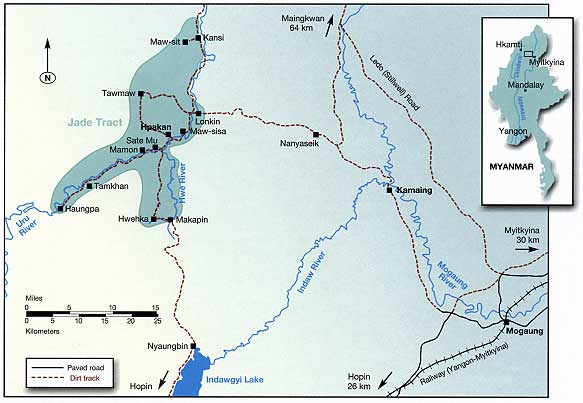 |
| Figure 2. Hpakan is the center of the jadeite mining district (or central Jade Tract) in north-central Burma. There are two main routes into the Hpakan region, one from Mogaung and the other from Hopin. Adapted by R.W. Hughes and G. Bosshart from Hind Co. Map (1945). |
![]() While Mogaung was formerly an important jadeite trading center, this is no longer the case. The present center of the mining district is Hpakan (Hpakant, Phakan, Phakant), a small town about 16 km by road southeast of Tawmaw that lies along the Uru River. Tawmaw, the village adjacent to the most famous primary jadeite outcrop, lies some 120 km (75 miles) northwest of Mogaung. Other important towns in the area, also along the Uru River, include Lonkin (Lon Hkin) and Sate Mu (Seikmo, a.k.a. Sine Naung). The important mining town of Hwehka (Hweka) is located some 20 km due south of Hpakan, along the Hwe River (hka means river). Jadeite is also mined at Makapin (Makabin), just east of Hwehka. With the exception of Hwehka and Makapin, no jadeite mining takes place east of the Uru River.
While Mogaung was formerly an important jadeite trading center, this is no longer the case. The present center of the mining district is Hpakan (Hpakant, Phakan, Phakant), a small town about 16 km by road southeast of Tawmaw that lies along the Uru River. Tawmaw, the village adjacent to the most famous primary jadeite outcrop, lies some 120 km (75 miles) northwest of Mogaung. Other important towns in the area, also along the Uru River, include Lonkin (Lon Hkin) and Sate Mu (Seikmo, a.k.a. Sine Naung). The important mining town of Hwehka (Hweka) is located some 20 km due south of Hpakan, along the Hwe River (hka means river). Jadeite is also mined at Makapin (Makabin), just east of Hwehka. With the exception of Hwehka and Makapin, no jadeite mining takes place east of the Uru River.
![]() Two major dirt roads lead into the mining district, one from Mogaung and the other (the more mountainous route) from Hopin (again, see figure 2). The authors traveled both routes – via modified trucks, cars, motorbikes, ponies, elephants, and on foot.
Two major dirt roads lead into the mining district, one from Mogaung and the other (the more mountainous route) from Hopin (again, see figure 2). The authors traveled both routes – via modified trucks, cars, motorbikes, ponies, elephants, and on foot.
![]() The area is a highly dissected upland, consisting of ranges of hills that form the Chindwin-Irrawaddy watershed (Chhibber, 1934b). Loimye Bum, an extinct volcano north of Kansi and the highest peak in the area, is 1,562 m above sea level. Tawmaw is 840 m, and Hpakan is 350 m, above sea level. The hills are covered with dense jungle. This is the area through which the Stillwell (Ledo) Road (Eldridge, 1946) was built, which was the scene of fierce fighting during World War II.
The area is a highly dissected upland, consisting of ranges of hills that form the Chindwin-Irrawaddy watershed (Chhibber, 1934b). Loimye Bum, an extinct volcano north of Kansi and the highest peak in the area, is 1,562 m above sea level. Tawmaw is 840 m, and Hpakan is 350 m, above sea level. The hills are covered with dense jungle. This is the area through which the Stillwell (Ledo) Road (Eldridge, 1946) was built, which was the scene of fierce fighting during World War II.
|
![]() So brutal is the climate and so poor are the roads that travel is extremely difficult during the May–October monsoon season. Indeed, the November–April dry season is the only time one can be sure of reaching the mines. The authors’ first trip, in early June 1996, took three days of struggling through mud to travel the approximately 56 km from Hopin to Hpakan, with a mere 8 km traveled on the second day. The return trip on the “good” road to Mogaung took more than 15 hours. At times during the rainy season, some areas are accessible only by foot, donkey, or elephant (figure 3). But the dry season has its challenges, too. Whereas by November the roads again become accessible by motor vehicle (eight hours for the Mogaung–Hpakan trip), the brown mud is transformed into dust clouds that cloak entire valleys.
So brutal is the climate and so poor are the roads that travel is extremely difficult during the May–October monsoon season. Indeed, the November–April dry season is the only time one can be sure of reaching the mines. The authors’ first trip, in early June 1996, took three days of struggling through mud to travel the approximately 56 km from Hopin to Hpakan, with a mere 8 km traveled on the second day. The return trip on the “good” road to Mogaung took more than 15 hours. At times during the rainy season, some areas are accessible only by foot, donkey, or elephant (figure 3). But the dry season has its challenges, too. Whereas by November the roads again become accessible by motor vehicle (eight hours for the Mogaung–Hpakan trip), the brown mud is transformed into dust clouds that cloak entire valleys.
| Box C: Monsoon madness: Reaching Jade Land in the wet season CAUTION? HE MISSED the train in Mandalay. So for the monsoon trip between Hopin and Hpakan we are saddled with a beetle-nut fueled speed freak who is obviously being paid by Toyota to determine the amount of side torque a wheel can take before shearing from its axle.
|
Population. The population of Burma’s Kachin State consists mainly of Shan, who dominate the major towns and valleys, and Kachin, who traditionally inhabit the hills (Hertz, 1912). The jade mines themselves feature a mixture of different peoples from around the country, lured by the promise of riches. During our visits to the mines, we met Kachin, Shan, Chinese, Chin, Wa, Rakhine, Nepalese, and Panthay. Today, however, immigrants from China increasingly dominate the towns and trade of northern Burma.
Hpakan today – “Little Hong Kong.” Over the past few years, the Burmese government has liberalized regulations concerning the gemstone sector, including the jade trade. For the first time in several decades, Burmese citizens are allowed to trade in gems, and even to sell to foreigners (“Myanmar Gemstone Law,” September 29, 1995). Nevertheless, conducting business in Burma continues to be difficult, especially for noncitizens.
![]() Since the 1994 peace agreement between the Kachin rebel groups and the government, thousands of people from across Burma have flocked to the Hpakan area to look for jade. Like the gold rush towns of America’s Old West, Hpakan and neighboring Sate Mu (Sine Naung) have a transient air. None of the many people we met had been at the mines for more than a decade, and most had been there less than a year. Likewise, none of the government or military officials encountered in 1996 was there nine months later.
Since the 1994 peace agreement between the Kachin rebel groups and the government, thousands of people from across Burma have flocked to the Hpakan area to look for jade. Like the gold rush towns of America’s Old West, Hpakan and neighboring Sate Mu (Sine Naung) have a transient air. None of the many people we met had been at the mines for more than a decade, and most had been there less than a year. Likewise, none of the government or military officials encountered in 1996 was there nine months later.
![]() Still, wealth lurks just below the surface, with satellite dishes sitting atop tin-roofed huts. Indeed, the locals refer to Hpakan as “little Hong Kong,” because it is said that one can get anything there, including fine cognac, expensive watches, dancing girls, and heroin. It should be noted, too, that the area has a very high incidence of AIDS.
Still, wealth lurks just below the surface, with satellite dishes sitting atop tin-roofed huts. Indeed, the locals refer to Hpakan as “little Hong Kong,” because it is said that one can get anything there, including fine cognac, expensive watches, dancing girls, and heroin. It should be noted, too, that the area has a very high incidence of AIDS.
|
The first Western geologist to visit the mines was Fritz Noetling, who published his report in 1893. A.W.G. Bleeck followed with reports in 1907 and 1908. However, the most detailed account of the geology of the jadeite deposits is that of Harbans Lal Chhibber (1934a and b), who spent two years doing field work in the area, commencing in 1928. While substantial work has since been done by Burmese geologists, little of this is available to Western scientists. Thus, Chhibber’s reports remain the classic references on the subject. All those who have come after him, including Soe Win (1968), based their descriptions on Chhibber’s publications.
|
|
Primary Deposits. The classic primary occurrence of jadeite is on the plateau at Tawmaw. This area has been worked for over a hundred years and is said by miners to have produced all color varieties of jadeite. Other primary outcrops are found in the west, northwest, and northeast portions of the Jade Tract.
![]() In each of the primary deposits, jadeitite dikes cross-cut the serpentinized peridotite parallel to shear zones following northeasterly strikes and dips from 18° to 90°SE. Dike thicknesses are poorly reported, probably because of weathering and the irregular swelling, pinching, and faulting-off of the dikes; however Soe Win (1968) does give a width of 5–8 feet (1.5–2.5 m) for the Khaisumaw dike at Tawmaw. Some dikes contain only jadeite and albite, while others have a boundary (on one or both sides) of amphibolite-eckermannite-glaucophane (dark gray to blue-black) or actinolite (dark green). The boundary with serpentinite is marked by a soft, green border zone that consists of a mixture of the adjacent vein minerals and chlorite, with or without calcite, actinolite, talc, and cherty masses (Chhibber, 1934b; Soe Win, 1968).
In each of the primary deposits, jadeitite dikes cross-cut the serpentinized peridotite parallel to shear zones following northeasterly strikes and dips from 18° to 90°SE. Dike thicknesses are poorly reported, probably because of weathering and the irregular swelling, pinching, and faulting-off of the dikes; however Soe Win (1968) does give a width of 5–8 feet (1.5–2.5 m) for the Khaisumaw dike at Tawmaw. Some dikes contain only jadeite and albite, while others have a boundary (on one or both sides) of amphibolite-eckermannite-glaucophane (dark gray to blue-black) or actinolite (dark green). The boundary with serpentinite is marked by a soft, green border zone that consists of a mixture of the adjacent vein minerals and chlorite, with or without calcite, actinolite, talc, and cherty masses (Chhibber, 1934b; Soe Win, 1968).
![]() A Tawmaw mine director told GB and TO that the main dike was traceable north-northwest to Hkamti and Chindwin and even to India, surfacing and diving “like a serpent,” with another branch running north to Putao. However, the recent visit to Hkamti (see pp. 14–15) and geologic constraints argue against this interpretation. Rather, the Jade Tract and Hkamti jadeite deposits appear to originate from separate, deep-seated serpentinite bodies that perhaps were derived from the same collisional process, and Putao appears to produce a different jade-like material, obviously with a different origin.
A Tawmaw mine director told GB and TO that the main dike was traceable north-northwest to Hkamti and Chindwin and even to India, surfacing and diving “like a serpent,” with another branch running north to Putao. However, the recent visit to Hkamti (see pp. 14–15) and geologic constraints argue against this interpretation. Rather, the Jade Tract and Hkamti jadeite deposits appear to originate from separate, deep-seated serpentinite bodies that perhaps were derived from the same collisional process, and Putao appears to produce a different jade-like material, obviously with a different origin.
|
Box D: The yin-yang of nephrite mining
Geoffrey Wills, 1972, Jade of the East |
Secondary Deposits. Most jadeite is recovered from secondary deposits in the Uru Boulder Conglomerate (figure 4), southeast of the Tawmaw-hosting serpentinite body. The conglomerate is exposed over an area 3–6.5 km in width, which is widest at Mamon. It ranges up to 300 m thick and is probably Pleistocene to sub-Recent (Chhibber, 1934b). South of Hwehka, however, jadeite boulders are found in conglomerate interlayered with blue-gray sands and coal seams that are believed to be derived from a Tertiary (Miocene?) species of tree (Bleeck, 1908; Chhibber, 1934a). Typical secondary deposits are located mostly west of the Uru River, including Sate Mu, Hpakangyi (adjacent to Hpakan), and Maw-sisa.
|
Mining Techniques
Dike Mining. Unlike secondary deposits, where the miner has to determine which of the myriad boulders is jadeite, the dikes contain readily recognizable material. Historically, miners started a fire near the dike and then threw water on the rock to crack it. Today, at Tawmaw, often miners first must use backhoes, scrapers, and other earth-moving equipment to expose the jadeite dikes, or rudimentary digging to create shafts to reach them. Shafts observed at the time of RWH and FW’s 1997 visit reached depths of approximately 10–20 m (figure 5). Once a dike is exposed, miners use dynamite and jackhammers to break the jadeite apart and away from the country rock (figure 6).
Boulder and Gravel Mining. The workings at Sate Mu and Maw-sisa are, in many respects, typical of secondary jadeite mines. The Uru Boulder Conglomerate is as much as 300 m deep in places, and alluvial mining has barely scratched the surface. It appeared from the open cuts that there is a huge quantity of material remaining to be extracted. We saw people working about 18 m down into the conglomerate, stripping it away with primitive tools.
|
![]() The first step in mining the conglomerate is removal of the overburden, taung moo kyen (literally, “head cap removal”). Since the “overburden” (per Chhibber, 1934b, a layer of alluvium of variable thickness followed by a pebble-gravel layer over the Uru Conglomerate) also may contain jadeite, workers must search this material, too. Each claim is only about 5 m wide; to keep from encroaching onto the neighbor’s area, miners leave a thin wall of conglomerate as a partition. Eventually the walls themselves weather away; nevertheless, when seen from above, the result is spectacular – several square kilometers of step-like benches, as if an ancient city were being excavated (figure 7). At Maw-sisa, diggers concentrated on mining a black conglomerate layer called ah may jaw, where jadeite is said to be richest.
The first step in mining the conglomerate is removal of the overburden, taung moo kyen (literally, “head cap removal”). Since the “overburden” (per Chhibber, 1934b, a layer of alluvium of variable thickness followed by a pebble-gravel layer over the Uru Conglomerate) also may contain jadeite, workers must search this material, too. Each claim is only about 5 m wide; to keep from encroaching onto the neighbor’s area, miners leave a thin wall of conglomerate as a partition. Eventually the walls themselves weather away; nevertheless, when seen from above, the result is spectacular – several square kilometers of step-like benches, as if an ancient city were being excavated (figure 7). At Maw-sisa, diggers concentrated on mining a black conglomerate layer called ah may jaw, where jadeite is said to be richest.
|
![]() Miners admitted that production was erratic at best. While occasionally they would find 20–30 pieces in a single day, often they would not recover any jadeite boulders for days. Most of these boulders weigh less than 1 kg, although some reach 300 kg. Only a tiny fraction of the jadeite boulders recovered contain jewelry-quality material.
Miners admitted that production was erratic at best. While occasionally they would find 20–30 pieces in a single day, often they would not recover any jadeite boulders for days. Most of these boulders weigh less than 1 kg, although some reach 300 kg. Only a tiny fraction of the jadeite boulders recovered contain jewelry-quality material.
|
Miners also look for a characteristic fibrous texture (yumm) in some jadeite boulders. Although jadeite jade is not normally thought of as having fibrous texture, it sometimes is found in jade that is 100% jadeitic pyroxene and in other cases may be related to partial replacement by – or admixture with – an amphibole (Htein and Naing, 1994, 1995). Also, jadeite is typically smoother than most other boulders and will not show the crystalline reflections (possibly from mica or quartz) often seen in the others. Another indicator of jadeite is a type of sheen, called shin. Black shin is said to “infect” or “damage” the stone; the miners consider it a harbinger of bad luck. According to Chhibber (1934b), shin is amphibolite or amphibole schist. Such an impurity would account for the lower quality of this jadeite.
![]() Jadeite jade also has a greater “heft” (specific gravity of about 3.34) than other types of rocks in the conglomerate. In addition, divers feel that it sticks slightly to their hands or feet under water, a property that has been used historically by the Chinese to separate both jadeite and nephrite from substitutes (“The art of feeling jade,” 1962).
Jadeite jade also has a greater “heft” (specific gravity of about 3.34) than other types of rocks in the conglomerate. In addition, divers feel that it sticks slightly to their hands or feet under water, a property that has been used historically by the Chinese to separate both jadeite and nephrite from substitutes (“The art of feeling jade,” 1962).
Maw-Sit-Sit. The Maw Sit vein, which produces maw-sit-sit, lies about 2 km from Kansi at the northeastern end of the Jade Tract (again, see figure 2). The maw-sit-sit mine consists of a narrow, vertical trench cut that is some 9 m deep. The total length of the active mining area in November 1997 was approximately 200 m.
Other Jadeite Localities in Burma
According to Chhibber (1934b), other occurrences of jadeite in present-day Burma include Mawhun, 20 km southwest of Mohnyin, and a site on the bank of the Chindwin River, in the Hkamti area. It is possible that the latter reference is actually to the Nansibon mining region, described below, which was recently visited by one of the authors (GEH). The United Nations (1979) reported the extraction of low-quality jade from steeply dipping late-Tertiary boulder conglomerates in the Indaw-Tigyang area, which extends another 50 km south of Mawhun. Similar conglomerates were observed at Nansibon (again, see below).
|
Hkamti Area: Nansibon and Natmaw. On an expedition to the jade mines by a group traveling under the auspices of the American Museum of Natural History in January and February 2000, four geologists and two gemologists visited the mining area called Nansibon (Namsibum, Manhsibon). It was the first recorded visit by Western gemologists to this area. Located in the Sagaing Division, about 35 km (22 miles) southeast of the Chindwin River town of Hkamti, Nansibon is a group of joint-venture tracts that extend about 2 km along a north-south trending ridge in the middle of dense jungle (central location at N25°51'24", E95°51'30" determined by GPS measurements). The deposit is a steeply inclined (60°–90°E) serpentinite boulder conglomerate in which jadeite cobbles from a few centimeters to perhaps one meter in diameter are “concentrated” in a few narrow horizons. Mining is restricted to mechanized excavation of surface exposures of the conglomerate (figure 11), which disappears both north and south under Tertiary river sands and lake sediments of the Chindwin basin. Now largely unworked, Natmaw (Nawmaw, Nathmaw) is a smaller area roughly 30 km south of Nansibon, where miners have explored jadeite dikes in serpentinite. As the road there was impassable and time was constrained, the group could not visit these latter mines.
![]() According to current and retired officials from the Myanma Gems Enterprise (MGE), relative to the Jade Tract, Nansibon presently produces a large portion of the gem-quality Imperial jadeite mined in Burma, lesser amounts of other colors and “commercial” jadeite (used for carvings and bangles), and small amounts of “utility” jade (used for tiles, building veneers, and very large carvings; “Myanma jade,” 1991). During the recent visit, GEH and gemologist Robert Kane acquired a comprehensive suite of jadeite from Nansibon in colors including black and many shades of green, lavender, blue-green, “nearly blue,” and “carnelian orange”; these varied from translucent to semi-translucent. They saw numerous small (2–5 mm diameter) cabochons of translucent Imperial green jadeite from Natmaw.
According to current and retired officials from the Myanma Gems Enterprise (MGE), relative to the Jade Tract, Nansibon presently produces a large portion of the gem-quality Imperial jadeite mined in Burma, lesser amounts of other colors and “commercial” jadeite (used for carvings and bangles), and small amounts of “utility” jade (used for tiles, building veneers, and very large carvings; “Myanma jade,” 1991). During the recent visit, GEH and gemologist Robert Kane acquired a comprehensive suite of jadeite from Nansibon in colors including black and many shades of green, lavender, blue-green, “nearly blue,” and “carnelian orange”; these varied from translucent to semi-translucent. They saw numerous small (2–5 mm diameter) cabochons of translucent Imperial green jadeite from Natmaw.
Putao. Jadeite is also found some 320 km (200 miles) north of Myitkyina, near Putao, but the deposit was reported by Chhibber to be inaccessible and the quality of the jadeite poor. Harlow and Kane were told by U Shwe Maik, former director of jade acquisition for MGE, that the alleged jade from Putao is actually green massive hydrogrossular (now hibschite). They obtained a sample for study.
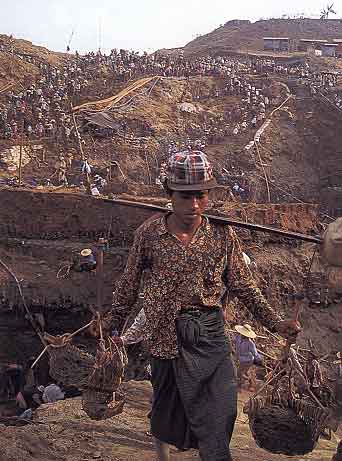 |
Figure 12. Thousands of workers remove the dirt and gravel at Hpakangyi to reach the Uru conglomerate and its promise of fine jadeite. Using the most rudimentary of carrying devices – two crudely fashioned bamboo buckets – this young miner leads a trail of laborers up the steep path from the bottom of the pit to a truck that will carry the waste to the river. Photo © Richard W. Hughes. |
Conclusion – Riding the Snake
A truck slowly moves alongside the small river that snakes through a valley bottom. Hundreds of years before, thick jungle lay everywhere. Today all that is visible is brown, earth, brown, earth, ubiquitious. Eventually it arrives at Hpakangyi (Figure 12). As one crosses the rise separating Hpakan from Hpakangyi, all becomes clear. More than 10,000 workers coat an excavation several hundred feet deep, digging, carrying, shifting, loading, delving their way to heaven, perched atop the head of a long green snake whose coils extend around the world. It is here that the green stone is found in its finest quality.
![]() Bridge to heaven or ladder to hell? That matters little to the diggers. For while patience might be a virtue to the laopans, coolies are paid only by how much earth they carry, just a few cents per load. They have no time for patience. They care little for jade itself, seeing the green stone only as a road to gold – an escape from the poverty endemic to most of Burma. As one miner declared in broken English: “I am fortune seeker!” He made no mention of seeking jade. Patience? For the coolies, too much patience only prolongs their stay in hell.
Bridge to heaven or ladder to hell? That matters little to the diggers. For while patience might be a virtue to the laopans, coolies are paid only by how much earth they carry, just a few cents per load. They have no time for patience. They care little for jade itself, seeing the green stone only as a road to gold – an escape from the poverty endemic to most of Burma. As one miner declared in broken English: “I am fortune seeker!” He made no mention of seeking jade. Patience? For the coolies, too much patience only prolongs their stay in hell.
|
Catching Heaven’s Stone
As afternoon stretches towards evening, waste is piled into a waiting truck. When full, the mechanical beast leaves Hpakangyi, twisting along the Uru river. Crossing a bridge, it empties its waste directly in the river that bisects Hpakan, center of the jade universe.
![]() At the dump there are no Chinese bosses, no onlookers, no audience, only the search and the searchers. While trucks disgorge their loads, jade pickers scramble over the river bank. Nothing to carry, no price per load – all is stripped bare – only the essentials. Along the river, only one thing remains – the prize (Figure 13).
At the dump there are no Chinese bosses, no onlookers, no audience, only the search and the searchers. While trucks disgorge their loads, jade pickers scramble over the river bank. Nothing to carry, no price per load – all is stripped bare – only the essentials. Along the river, only one thing remains – the prize (Figure 13).
|
|
![]() The stone is quickly taken to a wooden dwelling on a hill above Hpakan – no time to spare, hurry, hurry. There a laopan calmly waits. Patience, patience – he knows those who hurry lose, they miss the prize, they don’t find heaven.
The stone is quickly taken to a wooden dwelling on a hill above Hpakan – no time to spare, hurry, hurry. There a laopan calmly waits. Patience, patience – he knows those who hurry lose, they miss the prize, they don’t find heaven.
![]() After a brief examination, a bid is offered, refused, then a counteroffer accepted. While the laopan counts out a pile of mud-stained bills, he smiles to himself, content with the thought that he, the patient one, is now one step closer to heaven. As for the digger, he simply walks away, thinking quietly to himself…
After a brief examination, a bid is offered, refused, then a counteroffer accepted. While the laopan counts out a pile of mud-stained bills, he smiles to himself, content with the thought that he, the patient one, is now one step closer to heaven. As for the digger, he simply walks away, thinking quietly to himself…
![]() His track leads down to the small encampment he calls home. As the sun’s final glow fades, its aura illuminates the digger preparing for the night ahead. With a mortician’s care, all the possessions in his earthly world are gathered together and placed into burlap sacks. These are then strapped onto a mule’s saddle, a stone from the nearby river helping to balance the load.
His track leads down to the small encampment he calls home. As the sun’s final glow fades, its aura illuminates the digger preparing for the night ahead. With a mortician’s care, all the possessions in his earthly world are gathered together and placed into burlap sacks. These are then strapped onto a mule’s saddle, a stone from the nearby river helping to balance the load.
![]() As dusk descends he sets off into the mist, carefully working his way alongside the small river snaking through the valley bottom (figure 15). Brown morphs into
green, as the surrounding jungle exerts
its hold on the land. While the sticky
green glow eventually fades to black,
the sounds of human activity disappear
into the distance. Soon, the only noise
is that of the man whistling softly,
urging the animal on. Clip, clop, hoof
against stone, one foot in front of the
other, each step a mark of patience – down
the track… under the moonlight… through
history… into immortality… away
from hell… towards heaven….
As dusk descends he sets off into the mist, carefully working his way alongside the small river snaking through the valley bottom (figure 15). Brown morphs into
green, as the surrounding jungle exerts
its hold on the land. While the sticky
green glow eventually fades to black,
the sounds of human activity disappear
into the distance. Soon, the only noise
is that of the man whistling softly,
urging the animal on. Clip, clop, hoof
against stone, one foot in front of the
other, each step a mark of patience – down
the track… under the moonlight… through
history… into immortality… away
from hell… towards heaven….
References & Acknowledgments
References
and acknowledgments for this article
appear at the end of Part
2.
Click here to view Part 2 of this article
Click here to read about Russian jadeite
Footnotes
*In the Burmese vernacular, the
country has always been called Myanmar.
The ruling Burmese military junta changed
the English name of the country from
Burma to Myanmar shortly after the anti-government
riots of 1988. However, many Burma watchers
(both Burmese and foreign alike) feel
that the country should be referred to
as Burma until such a time that a democratically-elected
government decides to change the name
(Burma Action Group, 1996) (back
to text)
